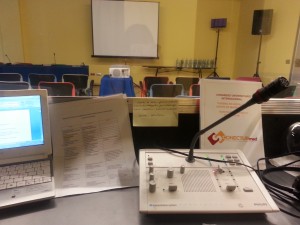junio
Here are some tips that work for me, I hope you will find it useful:
- Prepare the interpretation whenever you can, this means that you must read as many texts as you can around the conference or meeting subject and always read them in the two languages you work with. It’s the best way to become familiar with the subject’s typical vocabulary and expressions. Sometimes, it is also useful to check bilingual glossaries comparing them to texts because, as we all know, glossaries don’t always offer the adequate term.
- Create your own glossary. Once you have read few texts in both languages, it is advisable to capture all that in a glossary and, if necessary, to include contexts in case you need it, who knows…
- Memorise your glossary. This one is a VERY IMPORTANT getting-ready-for-work step. We must bear in mind that the glossary that we are going to take with us will only be there if we have a memory lapse. In my case, it brings me confidence, I always think: “well, if I forget something, I still have the glossary”. However, I must admit that I don’t use it a lot as I always memorise it previously.
- Prepare post-its with the most recurring or most important ideas, expressions and terms that you find hard to memorise. You can stick them on the booth on the D-day. In my first interpreting assignments, I used to have my glossary on hand thinking that it would be sufficient but then I learnt that while interpreting I rarely have time to check a word. One day, a friend of mine suggested the post-it solution. The idea seemed quite good to me and I decided to put it into practice. It worked perfectly for me. Nevertheless, I try not to use more than five or six, otherwise I get lost!
- Nowadays wifi connection is available everywhere but it not, benefit from the smart phones era. I know that some colleagues have the wireless flash drives but here is a cheaper option: use your mobile phone’s connection. I have a rather quick mobile phone internet connection so I take advantage of it and I connect from my netbook using Bluetooth connection pairing the phone with the netbook. You just need to have Bluetooth in you netbook and if you don’t, you can buy an adaptor. This helps you have Internet in booth for any research. Although you can also search straight from the mobile phone, I must admit that I’m very clumsy and slow with touchscreens and their tiny keys. I therefore prefer, by far, my netbook in a booth.
- Always arrive early to the event in order to test the booth with the technician, the quality of the sound and to install your “equipment”. you can also make use of that moment to check if a speaker intends to use a video. People don’t always think of the subtitles and, as we will have to do the job live, it’s better to watch it at least once to take notes. I’m telling this because I already experienced it.
- Always remain calm if the sound fails at a certain moment. Obviously, if it fails for a long time we will have to let the technician know about it, but sometimes there are “turbulences” (Once I even heard the radio!) which last few seconds and that is when we will have to resort to our interpreter mental alertness so as to palliate that dreadful silence always misunderstood by the audience.
- Work, every time you can, with a booth partner whose mother tongue is your second language. This is, in my opinion, the ideal booth situation and, if both interpreters are competent, it will provide the client with a more than satisfactory result.
- Do not interpret into a language that is not your mother tongue or, at least, that you don’t master perfectly. This piece of advice seems obvious but I have noticed that a lot of interpreters tend to overestimate their capacities in a non mother tongue when they actually don’t master it. Be sure that this will be noticed in a booth. It’s definitely better to work with one combination and do a good job than to work with different combinations ending up being a mediocre of the profession: do not bite off more than you can chew.
- Be always prepared for unexpected events. Yes, welcome to the simultaneous interpreting world! No matter how ready we are and how much prediction we try to have, there will always be unexpected events or setbacks and this is also the reason why we are so essential to good communication.



